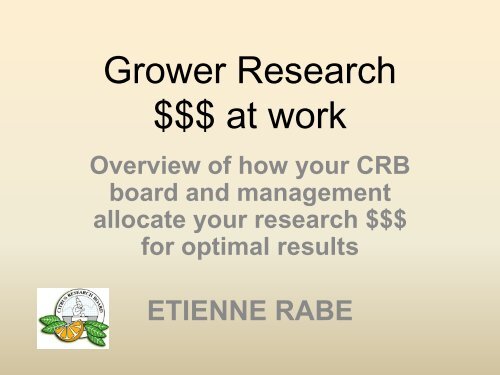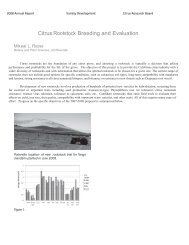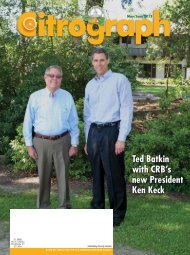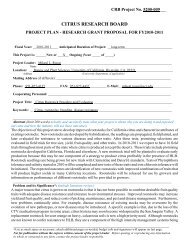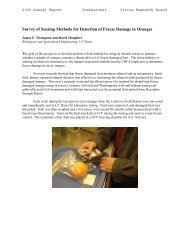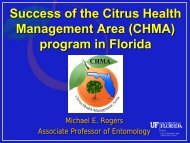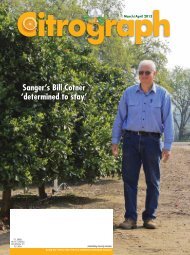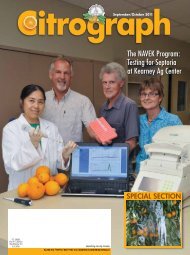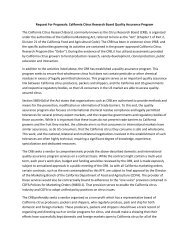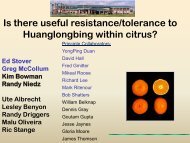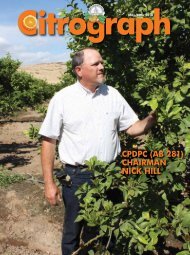Grower Research $$$ at work - Citrus Research Board
Grower Research $$$ at work - Citrus Research Board
Grower Research $$$ at work - Citrus Research Board
You also want an ePaper? Increase the reach of your titles
YUMPU automatically turns print PDFs into web optimized ePapers that Google loves.
<strong>Grower</strong> <strong>Research</strong><strong>$$$</strong> <strong>at</strong> <strong>work</strong>Overview of how your CRBboard and managementalloc<strong>at</strong>e your research <strong>$$$</strong>for optimal resultsETIENNE RABE
CRB Mission• Mission:To keep the California citrusindustry economically viable
Content• <strong>Research</strong> assessments over past 3years and spending alloc<strong>at</strong>ion• <strong>Research</strong> priorities: subcommitteesA. Vectored diseasesB. Pest managementC: Postharvest and non-vectoredD: New Variety DevelopmentE: Production efficiency
<strong>Research</strong> assessments (40lbs field carton)• St<strong>at</strong>utory assessments• <strong>Grower</strong> referendum every 4 years• Max assessment @7c/40 lb fieldproduction• 12/13 = 3.6c and 11/12 was 3.0c• Total assessment income:12/13 (projected) = $6,699m;11/12 = $5,343m
12/13 11/12 10/11 09/10<strong>Research</strong> 4,701 3,626 2,978 2,716CCPP 483 546 568 474CCQC 525 468 513 534Other 3,874 4,017 4,124 3,529Sub-Total CRB 9,586 8,657 8,183 7,253Sub-Contracts 3,405 3,760 3,338 2,139TOTAL: 12,991 12,417 11,521 9,392
<strong>Research</strong> funding• Universities, USDA, priv<strong>at</strong>e researchentities• R&D funding: can industry share indownstream commercializ<strong>at</strong>ion offunded innov<strong>at</strong>ion?
Adding tools to the ToolboxNew <strong>Research</strong> Developments tokeep California competitive
Content• <strong>Research</strong> assessments over past 3 yearsand spending alloc<strong>at</strong>ion• <strong>Research</strong> priorities: subcommitteesA. Vectored diseases [14%]***B. Pest management [28%]***C: Postharvest and non-vectored [7%]D: New Variety Development [20%]E: Production efficiency [31%]***
A. Vectored diseases• ACP/HLB fight – main emphasisDetection: molecular; vol<strong>at</strong>ile sensors; fielddevicesACP: monitoring; <strong>at</strong>tractants; repellents;<strong>at</strong>tract and kill; biological control[Plant defense: nutritional (Florida)]• Other diseases: tristeza
ACP/HLB challenge• Approx 60% ($3,0m) of research budget• ACP management: chemical control, biocontrol,monitoring• HLB: early, reliable detection; presymptom<strong>at</strong>icdetection; therapeutics
Optimizing Chemical Control ofAsian <strong>Citrus</strong> Psyllid in CaliforniaJoseph Morse, Jim Bethke, Frank Byrne, BethGrafton-Cardwell, & Kris Godfrey
Developing a Management Plan forAsian <strong>Citrus</strong> Psyllid in Container Treesand Retail Nurseries: Evalu<strong>at</strong>ingUptake and Retention of SystemicInsecticides in Containerized <strong>Citrus</strong>Frank ByrneM<strong>at</strong>thew Daugherty, Elizabeth Grafton-Cardwell, Joseph MorseUniversity of California RiversideJames BethkeU.C. Cooper<strong>at</strong>ive Extension4.50-5.05 Aug 22, 2012
Developing <strong>at</strong>tract and killstr<strong>at</strong>egies to suppressACP
Identific<strong>at</strong>ion of Odor-Based Lures and Repellentsfor the Asian <strong>Citrus</strong> PsyllidCRB Project No. 5500-186
Odor-based lures and repellents*****TrapRepelExpected Outcomes:1. Improve traps2. Trap and kill
Auto-dissemin<strong>at</strong>or for Ifr spores
Development of auto-dissemin<strong>at</strong>or fordispersal of fungal p<strong>at</strong>hogen spores(Isaria fumosorosea)Greenhouse tests with free-flying ACP
Infected ACP nymph clustersfrom trialsABIfr-infected nymphIfr mycelium on cadavers & excrement
Biocontrol: Release andMonitoring of Tamarixia inSouthern CaliforniaMark Hoddle & Raju PandeyEntomology, UC Riverside
Tamarixia female foraging on a p<strong>at</strong>ch of ACPin AzusaAnts tending ACP nymphsACP mummies from which Tamarixiahas emerged in Bell GardensTamarixiaparasitizing ACPin the field in LosAngeles
HLB Diagnostics/Molecular• Small RNA’sapproaches• Field-deployable devices: multiplex• Distinguish live from dead Liberibactercells• “Nu-psyllid”: Federal grant – teamapproach• VOC sensor
Small RNA discovery in HLBaffectedcitrusHongwei ZhaoHailing JinDepartment Of Plant P<strong>at</strong>hology and MicrobiologyCenter For Plant Cell BiologyInstitute for Integr<strong>at</strong>ive Genome BiologyUniversity of California, Riverside
Devise and optimize an integr<strong>at</strong>ion approach to couple sample prepar<strong>at</strong>ion,isothermal amplific<strong>at</strong>ion and detection in a thin layer chrom<strong>at</strong>ographic system.R. Bruce Cary,Mesa TechSlide 23
Perspective - Biosensor for iPhone• Markers can be incorpor<strong>at</strong>edinto the m<strong>at</strong>rix (universalsensorchip)• The electrochemical detectionwill use impedance(resistance) - low powersource (any b<strong>at</strong>tery)• As target binds to markers –electric circuit is broken(resistance).• Vol<strong>at</strong>ile compounds can alsobe detected in a different setupNASA
CRB Project No. 5300-142Development, Valid<strong>at</strong>ion, and Deployment ofRapid, Inexpensive, Multiplex Assays forSimultaneous Detection and StrainCharacteriz<strong>at</strong>ion of Multiple <strong>Citrus</strong> P<strong>at</strong>hogensP. Scott White, Ph.D., Alina Deshpande, Ph.D., Jian Song, Ph.D.,Paul Li, Yolanda ValdezLos Alamos N<strong>at</strong>ional Labs, New Mexico
Distinguishing Live fromDead ‘Candid<strong>at</strong>usLiberibacter asi<strong>at</strong>icus’ in<strong>Citrus</strong> TissueGreg McCollum and Mark HilfUSDA, ARS, USHRLFt. Pierce, FL
NU-Psyllid• Federal $9m grant to team approach• [Need some more info here]
Field Deployable VOC Analyzerfor Early Detection of <strong>Citrus</strong>P<strong>at</strong>hogensRichard FinkApplied Nanotech, Inc.3006 Longhorn Blvd., Suite 107Austin, TX 78758dfink@appliednanotech.net512-339-5020 x130
EZ Knowz in Texas
The GC/DMS “suitcase”Adaption of suitcase to mobile pl<strong>at</strong>formUp-left: display of the portable GC/DMS structure; Up-middle:field sampling and analysis with the portable GC/DMS sensor;Up-right: solar panel for power supply; Left: a typical 3-Dvisualiz<strong>at</strong>ion of DMS spectra-- Yacht b<strong>at</strong>tery for 4 hours-- Power inverter + solar panel-- Sample injection with a suggestion from Reza Eshani (UF)-- Run each sample for 10 minutes30/2
THERAPEUTICTraditional managementversusnutritional supplementsLast ditch effort: str<strong>at</strong>egy touse when your grove ishighly infectedEffective nutritionalregimes includecontinuous psyllid control
5300-147Avoiding economic lossesin California citrus crop from<strong>Citrus</strong> tristeza virus stem pittingSvetlana Folimonova - Assistant Plant P<strong>at</strong>hologist, University of Florida, <strong>Citrus</strong><strong>Research</strong> and Educ<strong>at</strong>ion CenterGeorgios Vidalakis - Assistant Specialist in Cooper<strong>at</strong>ive Extension & AssistantPlant P<strong>at</strong>hologist, Director of <strong>Citrus</strong> Clonal Protection Program, Department ofPlant P<strong>at</strong>hology & Microbiology, University of California, RiversideRay Yokomi – <strong>Research</strong> Plant P<strong>at</strong>hologist, USDA-ARS, Parlier, CA
CTV declinePauma Valley, Southern California, July 2011
Stem pitting symptomsHealthyInfected
Content• <strong>Research</strong> assessments over past 3 yearsand spending alloc<strong>at</strong>ion• <strong>Research</strong> priorities: subcommitteesA. Vectored diseases [14%]B. Pest management [28%]C: Postharvest and non-vectored [7%]D: New Variety Development [20%]E: Production efficiency [31%]
Approach• Continuous <strong>at</strong>tention to chemicalcontrol, with emphasis on IPMand protecting the long termusage of specific chemistries• Biological control
Invasive Pests AffectingCalifornia <strong>Citrus</strong>*Glassy-winged sharpshooter (1995)*<strong>Citrus</strong> Peel miner (1998)*<strong>Citrus</strong> Leaf miner (2000)Diaprepes Root Weevil (2005)Light Brown Apple Moth (2007)Asian <strong>Citrus</strong> Psyllid (2008)Fruit Flies (periodic)
Pests Th<strong>at</strong> Have Recently ArrivedGlassy-winged sharpshooterHomalodisca coagul<strong>at</strong>aTexas <strong>Citrus</strong> Mite, Eutetranychus banksi<strong>Citrus</strong> Peelminer, Marmara gulosaYuma spider mite, Eotetranychus yumensis<strong>Citrus</strong> Leafminer, Phyllocnistis citrellaDiaprepes Root Weevil,Diaprepes abbrevi<strong>at</strong>us
<strong>Citrus</strong> Thrips, Scirtothrips citriWinged, adult citrus thripsWingless thrips nymphsWingless, 1st and 2 nd instar thrips
<strong>Citrus</strong> Red Mite, Panonychus citriMite damagedUndamagedMonitoring Methods•CRM examine 100 leaves per 10 acres for adult female mites•Pred<strong>at</strong>ory mites: examine underside of same leaves for active stagesof pred<strong>at</strong>ory mitesTre<strong>at</strong>ment Threshold8 Adult Female Mites/Leaf
FRB adult female (no males), Naupactus godmani (Crotch)
Adult beanthrips – anexport problemon CAshipments toAustralia andNew Zealand
Forktailed Bush K<strong>at</strong>ydid, Scudderia furc<strong>at</strong>aMonitoring Methods:Timed search for k<strong>at</strong>ydid nymphs and damaged fruitEgg sampling method?Tre<strong>at</strong>ment Threshold:Fruit susceptibility: March – JuneMost growers tre<strong>at</strong> as soon as they see k<strong>at</strong>ydidsCultural Controls: None knownBiological Control: Partially effective egg parasitesChemical control:Soft pesticides: diflubenzuron (Micromite), kryocide,spinetoram (Deleg<strong>at</strong>e)Broad spectrum pesticides: chlorpyrifos (Lorsban), cyfluthrin(Baythroid), fenprop<strong>at</strong>hrin (Danitol)K<strong>at</strong>ydid Damage
California RedScale,Aonidiella aurantiiBiological control isvery effective if broadspectrum insecticidesare avoided and treesare cared forDowngrading of fruitYield Loss
Citricola Scale, CoccuspseudomagnoliarumDamage: sooty Mold, yield lossesBiological control: poorTre<strong>at</strong>ment threshold: 0.5/leafChemical Control:Chlorpyrifos (Lorsban)acetamiprid (Assail), imidaclopridbuprofezin (Applaud)
Evalu<strong>at</strong>ion of a Three-Lure DetectionTrap against Medfly, Oriental Fruit Flyand Melon FlyRoger Vargas(5500-193) August 22, 2012, 2:20 AMC. capit<strong>at</strong>a-TML B. dorsalis-ME B. cucurbitae-RK
• New Farma Tech TMRWafer in Jackson Trap
Content• <strong>Research</strong> assessments over past 3 yearsand spending alloc<strong>at</strong>ion• <strong>Research</strong> priorities: subcommitteesA. Vectored diseases [14%]B. Pest management [28%]C: Postharvest and non-vectored [7%]D: New Variety Development [20%]E: Production efficiency [31%]
Breaking insect-rel<strong>at</strong>ed citrus trade barriersusing postharvest tre<strong>at</strong>mentsSpencer S. Walse*J. Steve TebbetsDavid ObenlandDavid HallJoe Morse (UCR)Beth Grafton Cardwell (UCR)Michael Rogers (UF)Beth Mitcham (UCD)
Quarantine insect pests:CA trade barriers“routine control w/ fumig<strong>at</strong>ion”ACPBTCRSWFTLBAM
Quarantine insect pests:CA trade barriers“Grand challenges”FRBOFFMFBMSBmites?eggs internal feeders tanks
Septoria spot of citrus caused by Septoria citri• A disease of leaves, fruit, and twigs of oranges,lemons, and grapefruit.• Occurs in many citrus-growing countriesEarly symptoms:Small, irregular, pitted,shallow lesionsAdvanced symptoms:Dark lesions th<strong>at</strong> extendinto the albedo.Pycnidiaproducingfiliform conidia
Postharvest packinghousetre<strong>at</strong>ments: approach• Protecting the limited chemical optionsavailable for postharvest tre<strong>at</strong>ments;evalu<strong>at</strong>ing different combin<strong>at</strong>ions• Packinghouses have to be responsible inusing these chemicals to protect againstdanger of increased resistance• Adaskaveg and Smilanick
Postharvest decays of citrusGreen mold causedby Penicilliumdigit<strong>at</strong>um(most important oncitrus)Penicillium spp. arewound p<strong>at</strong>hogensBlue mold causedby P. italicum andgreen moldBrown rot caused byPhytophthora spp. Infectiothrough intact tissue.Penicillium soilage
Major postharvest decays of citrusSour rot caused by Geotrichum citri-aurantiiAlternaria decay caused byAlternaria sp.Tear stain and anthracnose caused byColletotrichum gloeosporioidesStem end rotcaused byLasiodiplodi<strong>at</strong>heobromae(B. rhodina)
Sour Rot of Lemons caused byGalactomyces citri-aurantiiPostharvest decay
New technologies to minimizepostharvest decay of citrus.Project 5600-106Joseph L. Smilanick, <strong>Research</strong> Plant P<strong>at</strong>hologistUSDA ARS 9611 S. Riverbend Avenue, Parlier CA93648 Joe.Smilanick@ars.usda.gov
Potassium phosphite label Calciumlabel expected
Wh<strong>at</strong> is theinfluence ofozone gas incitrus storage onthe survival ofdecay fungi?We have a large assortment of ozonechambers, gener<strong>at</strong>ors, and monitorsfrom other projects available for this<strong>work</strong>
CRB Project No: 5400-140
Fukumoto trees are susceptible to a disease orphysiological disorder called “foamy bark rot”
Content• <strong>Research</strong> assessments over past 3 yearsand spending alloc<strong>at</strong>ion• <strong>Research</strong> priorities: subcommitteesA. Vectored diseases [14%]B. Pest management [28%]C: Postharvest and non-vectored [7%]D: New Variety Development [20%]E: Production efficiency [31%]
5200-201Integr<strong>at</strong>ed <strong>Citrus</strong> Breeding andEvalu<strong>at</strong>ion for CaliforniaMikeal L. Roose and Tracy KahnCooper<strong>at</strong>ors: Glenn Wright, Peggy Mauk,Claire Federici, Ricki Kupper, Toni SiebertDavid Karp & Toni Siebert provided the many wonderful photos.
W. Murcott mandarin (left) and ‘Tango’ mandarin (right) froma mixed block planting with heavy cross-pollin<strong>at</strong>ion66
Navel Selections Evalu<strong>at</strong>edBahianinha Araras VI700Fulwood VI 593Bahianinha SRA513 VI 699UCR Early VI639LaneL<strong>at</strong>e VI352Parent navel orange VI 376
Limoneira 8ALemon Evalu<strong>at</strong>ions• Cultivars– Limoneira 8A: Standard– Femminello Siracusano 2KR, an irradi<strong>at</strong>edselection from ISA, Italy– Lemonade, sweet lemon hybrid, NZ– Meyer Lemon: Standard• D<strong>at</strong>a for selected traits from CVARS• Currently <strong>work</strong>ing on summarizing andanalyzing packing line d<strong>at</strong>a for abovecultivarsFemminello Siracusano 2KRVI 692Lemonade VI 734
‘Gold Nugget’ Mandarin70
Nova IR10Irradi<strong>at</strong>edSelection of ‘Nova’72
‘FairchildLS’ mandarinLow-seeded irradi<strong>at</strong>ed selection of ‘Fairchild’ mandarin73
‘Kinnow LS’ MandarinLow-seeded irradi<strong>at</strong>ed selection of ‘Kinnow’ mandarin74
The development of novel Bloodand Cara Cara like citrus varietiesThomson - Expression vectorsThilmony - Fruit specific promoters
Content• <strong>Research</strong> assessments over past 3 yearsand spending alloc<strong>at</strong>ion• <strong>Research</strong> priorities: subcommitteesA. Vectored diseases [14%]B. Pest management [28%]C: Postharvest and non-vectored [7%]D: New Variety Development [20%]E: Production efficiency [31%]
Optimiz<strong>at</strong>ion of w<strong>at</strong>er and nitr<strong>at</strong>eapplic<strong>at</strong>ion efficiency for <strong>Citrus</strong>trees: irrig<strong>at</strong>ion and fertig<strong>at</strong>ionpracticesAhmad B. Moradi, J. W. Hopmans, M. Kandelous, P.Hartsough, J. Simunek, ML. ArpaiaDepartment of Land, Air, and W<strong>at</strong>er Resources, University of California DavisDepartment of Environmental Sciences, University of California RiversideDepartment of Botany and Plant Sciences, University of California Riverside
Challenges for management of w<strong>at</strong>erand nutrients in the root zoneWh<strong>at</strong> happens to the applied w<strong>at</strong>er and nutrients? All enter the trees? Leachingbelow the root-zone? How much? Can I measure it?Transpir<strong>at</strong>ionIrrig<strong>at</strong>ion & Fertig<strong>at</strong>ionPrecipit<strong>at</strong>ionEvapor<strong>at</strong>ionRoot zoneLeaching to groundw<strong>at</strong>er(Environmental concern)
Rel<strong>at</strong>ionship betweenminimum m<strong>at</strong>urityand acceptability ofNavel OrangeMary Lu ArpaiaUC, RiversideDavid ObenlandUSDA-ARS
Overall goal: Re- examine currentminimum m<strong>at</strong>urity standard fornavel orange and rel<strong>at</strong>e results toe<strong>at</strong>ing qualityOUTCOME:The California Standard conceptbased on Brim A adopted by CAindustry April 1, 2012
BrixBrixCalifornia Standard vs R<strong>at</strong>io:rel<strong>at</strong>ionships to consumer acceptance% TA0.4 0.5 0.6 0.7 0.8 0.9 1.0 1.1 1.2 1.3 1.4 1.516.0 238 231 224 218 211 205 198 191 185 178 172 16515.5 229 223 216 210 203 196 190 183 177 170 163 15715.0 221 215 208 201 195 188 182 175 168 162 155 14914.5 213 206 200 193 186 180 173 167 160 153 147 14014.0 205 198 191 185 178 172 165 158 152 145 139 13213.5 196 190 183 177 170 163 157 150 144 137 130 12413.0 188 182 175 168 162 155 149 142 135 129 122 11612.5 180 173 167 160 153 147 140 134 127 120 114 10712.0 172 165 158 152 145 139 132 125 119 112 106 9911.5 163 157 150 144 137 130 124 117 111 104 97 9111.0 155 149 142 135 129 122 116 109 102 96 89 8310.5 147 140 134 127 120 114 107 101 94 87 81 7410.0 139 132 125 119 112 106 99 92 86 79 73 669.5 130 124 117 111 104 97 91 84 78 71 64 589.0 122 116 109 102 96 89 83 76 69 63 56 508.5 114 107 101 94 87 81 74 68 61 54 48 418.0 106 99 92 86 79 73 66 59 53 46 40 337.5 97 91 84 78 71 64 58 51 45 38 31 257.0 89 83 76 69 63 56 50 43 36 30 23 176.5 81 74 68 61 54 48 41 35 28 21 15 86.0 73 66 59 53 46 40 33 26 20 13 7 0The California Standard% TA0.4 0.5 0.6 0.7 0.8 0.9 1.0 1.1 1.2 1.3 1.4 1.516.0 40.0 32.0 26.7 22.9 20.0 17.8 16.0 14.5 13.3 12.3 11.4 10.715.5 38.8 31.0 25.8 22.1 19.4 17.2 15.5 14.1 12.9 11.9 11.1 10.315.0 37.5 30.0 25.0 21.4 18.8 16.7 15.0 13.6 12.5 11.5 10.7 10.014.5 36.3 29.0 24.2 20.7 18.1 16.1 14.5 13.2 12.1 11.2 10.4 9.714.0 35.0 28.0 23.3 20.0 17.5 15.6 14.0 12.7 11.7 10.8 10.0 9.313.5 33.8 27.0 22.5 19.3 16.9 15.0 13.5 12.3 11.3 10.4 9.6 9.013.0 32.5 26.0 21.7 18.6 16.3 14.4 13.0 11.8 10.8 10.0 9.3 8.712.5 31.3 25.0 20.8 17.9 15.6 13.9 12.5 11.4 10.4 9.6 8.9 8.3Current standard allows significant12.0 30.0 24.0 20.0 17.1 15.0 13.3 12.0 10.9 10.0 9.2 8.6 8.0amount of unacceptable fruit into11.5 28.8 23.0 19.2 16.4 14.4 12.8 11.5 10.5 9.6 8.8 8.2 7.711.0 27.5 22.0 18.3 15.7 13.8 12.2 11.0 10.0 9.2 8.5 7.9 7.310.5 26.3 21.0 17.5 15.0 13.1 11.7 10.5 9.5 8.8 8.1 7.5 7.0the marketplace (in red)10.0 25.0 20.0 16.7 14.3 12.5 11.1 10.0 9.1 8.3 7.7 7.1 6.79.5 23.8 19.0 15.8 13.6 11.9 10.6 9.5 8.6 7.9 7.3 6.8 6.39.0 22.5 18.0 15.0 12.9 11.3 10.0 9.0 8.2 7.5 6.9 6.4 6.08.5 21.3 17.0 14.2 12.1 10.6 9.4 8.5 7.7 7.1 6.5 6.1 5.78.0 20.0 16.0 13.3 11.4 10.0 8.9 8.0 7.3 6.7 6.2 5.7 5.37.5 18.8 15.0 12.5 10.7 9.4 8.3 7.5 6.8 6.3 5.8 5.4 5.07.0 17.5 14.0 11.7 10.0 8.8 7.8 7.0 6.4 5.8 5.4 5.0 4.76.5 16.3 13.0 10.8 9.3 8.1 7.2 6.5 5.9 5.4 5.0 4.6 4.36.0 15.0 12.0 10.0 8.6 7.5 6.7 6.0 5.5 5.0 4.6 4.3 4.0 81R<strong>at</strong>ioCalifornia Standard minimumstandard would elimin<strong>at</strong>eunacceptable fruit in themarketplace (in red)Key: Consumer AcceptanceNeither like norDislike dislike Like
California Standard vs E<strong>at</strong>ing QualityThis d<strong>at</strong>a shows th<strong>at</strong> fruit acceptability increases as theCalifornia Standard value increases in a linear manner. Each dotis an individual fruit th<strong>at</strong> was tasted. A total of 2630 fruit weretested.LikeExtremely987Hedonic Scale65432003-20042004-2005LikeSlightly22005-2006DislikeExtremely10 45 90 135 180 225California StandardSugar:Acid vsAcceptabilityHedonic Scale987654322003-20042004-20052005-200610 5 10 15 20 25 30 35SSC/TA R<strong>at</strong>io
The CA Standard shows a predictable linearprogression – as the score improves so doesconsumer acceptanceCurrent m<strong>at</strong>urity standards do not deliver fruit th<strong>at</strong> ensures consumers would want to repurchasePercentage of consumers who “would purchase” 1R<strong>at</strong>ioThe California Standard8080R 2 = 93%60604040202008.1 -8.58.6 -9.09.1 -9.59.6 -10.010.1 -10.510.6 -11.011.1 -11.511.6 -1212.1 -12.5072 - 83 84 - 91 92 - 99 100 -107108 -116117 -124125 -132133 -155R<strong>at</strong>io is not predictable (exhibits no logicalp<strong>at</strong>tern) in determining purchase intent . . .. . . while the CA Standard exhibits 90%+accuracy in determining purchase intentThe California Standard moreaccur<strong>at</strong>ely predicts purchase intent1. 2009 Tragon Study83
Assessing factors influencingthe postharvest quality ofCalifornia mandarinsMary Lu Arpaia (UC Riverside)David Obenland (USDA-ARS)
Response to Warm Temper<strong>at</strong>ureStorage – W. Murcott AfourerHedonic R<strong>at</strong>ing987654321* * * **5C 0 weeks 2 weeks 4 weeks0 1 2 3 4 5 6Weeks After PackingWarm temper<strong>at</strong>uremain cause of flavorlossTime in cold storageinfluences responseDifference enhancedwith gre<strong>at</strong>er fruitm<strong>at</strong>urity
<strong>Citrus</strong> Cryopreserv<strong>at</strong>ion to Increase SecurityofCritical CollectionsGayle VolkUSDA-ARS Fort Collins, ColoradoRichard Lee, Robert KruegerUSDA-ARS Riverside, California
<strong>Citrus</strong> shoot tip cryopreserv<strong>at</strong>ion: Remove freezeable w<strong>at</strong>er withincells to limit ice crystalliz<strong>at</strong>ion.Excise shoot tips0.3 M sucrose overnight2M glycerol/0.6 M sucrosePVS2 30 min 0 o CMicrograft ontoSeedling rootstockWarm in 1.2 M sucrosePlungeintoLiquid nitrogen(-196C)
Summary• Your <strong>Citrus</strong> <strong>Research</strong> <strong>Board</strong> andmanagement take the responsibility ofbeing custodian of industry moneyseriously• You can be assured th<strong>at</strong> the money isbeing spent judiciously for most bangfor the buck
THANK YOU !!!


